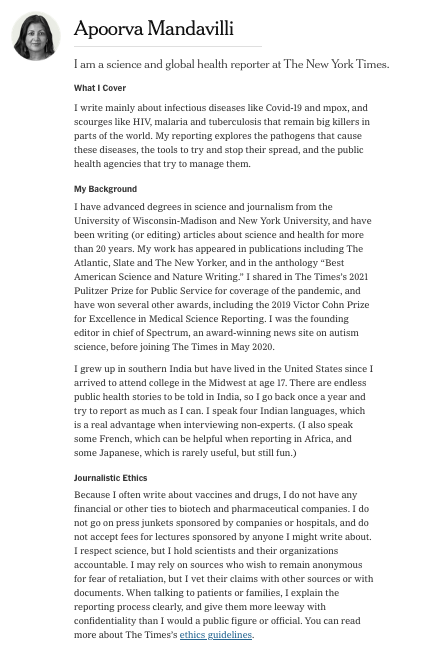Sophia Vento is a 2023-24 fellow at the Center for Journalism Ethics and an undergraduate student in the School of Journalism and Mass Communication at the University of Wisconsin–Madison.
Edmund Lee, an assistant editor on the New York Times Trust Team, recently helped launch a new initiative to boost trust with audiences by spotlighting journalism ethics issues in reporters’ author pages.
Implemented last month, this project seeks to address reader skepticism about reporter bias and cultivate a more explicit understanding of the journalistic process.

Prior to joining the Times as a media reporter in 2018, Lee wrote for Bloomberg, Businessweek, Advertising Age, Condé Nast Portfolio, Vibe, New York Magazine and The Village Voice. He also wrote and edited at Vox and Recode.
Lee spoke with us about the development of the Trust Team and its operations as well as what trust means to him. This story has been edited for clarity and brevity.
How did you come to be a part of the newsroom’s trust team? What does the team do?
I joined the Times as a media reporter. It was a really fun time because the media was changing. Media was going through so much transformation. But there was an opportunity to join a new group at the Times that they were calling trust and innovation.
The building question was how do we bridge this trust gap. It was not just this gap between readers and the Times readers, but the media altogether. A lot of it stems from what the Internet has wrought. News is no longer gatekept. The Internet has affected the news landscape, it’s affected democracy, it’s affected how readers think about the media. We needed to tackle that more head on.
We decided we needed to do a better job of explaining our process, explaining how journalism works, explaining what reporters do, who reporters are. One of those things is what we call enhanced bylines. It’s a snippet of text that runs below the byline. Readers aren’t necessarily aware of the fact that reporters have beats. They tend to think reporters are all generalists. The enhanced byline is a way to address that.
This is a big sea change for the Times, in particular, because the adage in journalism is that we’re not the story. We shouldn’t talk about ourselves. That actually has to change because readers are more aware that there is a journalistic process. When you don’t talk about it, when you don’t explain it, they’ll fill that void by presuming something, and often it’s the wrong thing. There is a very low level of news literacy and that explains a big part of this trust gap.
We’re updating the reporters’ author pages to show in a uniform way who we are and what we do. It describes in plain English what the reporter does and their background. We also have a new section called journalistic ethics that explicitly states how reporters operate, what we do as reporters, and the rules that we adhere to.
Now, to be really clear, Times reporters adhere to the same ethics guidelines. It’s very extensive. Anyone can read it, but few are aware of the guidelines in the first place. The point of this little section is to explain how that applies to that particular reporter. Again, it’s the same for everybody, but how it applies is slightly different for a business reporter versus a politics reporter versus a science and health reporter. From our research, we found this did a lot to address skepticism and develop more awareness for readers.
You’ll also notice it’s written in the first person, which is another big change. We discovered from research that having that personable tone made reporters more accessible to readers.
This is an issue for the Times in particular where we are often seen as this sort of cold, impenetrable institution. But that goes against exactly what it means to be a reporter. We are open. We come as a blank slate so to speak. We are impressionable by design. This change in how we present ourselves allows readers to understand us better as people. We go about our jobs with an open mind every single day. That’s the fun of being a journalist, and readers don’t know that.
The inclusion of the journalistic ethics statement on author’s pages is a very specific addition to a reporter’s biography. Was there a moment or turning point that prompted the team to implement this?
When the trust team was formed in 2021, we got in a room and discussed all kinds of different ideas. This was one of them. A lot of this stems from my time at Vox Media and Recode. We included in our author pages an ethics statement. Tech reporting, in particular, was rife with a lot of conflicts of interest. Reporters were very cozy with the subjects they wrote about — it wasn’t totally clear where that line was. At Recode, we were very clear what that line was. We said it up front.
I took that idea to the Times. Again, I don’t think it’s unique to what we were doing at Recode and Vox Media, but it probably was one of the only news sites around at that time that actually put out an explicit ethics statement. Of course, at the Times, it wasn’t a new thing. The Times has had an ethics guideline forever. It was just a matter of being more explicit about it.
It became more urgent, as the Times saw that generative AI was really becoming prominent and would obviously start to seep into the media landscape. We see there are potential benefits, but also a lot of pitfalls to what generative AI will do to the media ecosystem. The newsroom felt it was now more important than ever to highlight the people behind our work, that we’re not bots. We’re people with ethics and with a whole set of rules and practices. It’s important to highlight our personalities — our humanness so to speak.
Is there research suggesting the inclusion of ethics statements increases transparency and boosts trust?
We did do extensive research on the enhanced bio. The format — what I cover, my background, journalistic ethics and contact information — was all born out of this research. These were the specific areas that readers were very keen to know about our reporters.
Our existing reporter pages are all over the place. It’s just not really uniform.. They don’t always address the questions readers have.
First of all, readers inherently trust the Times. Certain segments of the readership don’t trust us, but in general, there is a high level of trust. However, when they come across a story they disagree with or find objectionable, that’s when they start to question the reporter.
If they’re fine with the story. They don’t even care who the reporter is. They just read the story. As soon as they come across a story that they don’t agree with, or don’t like, they will click on the reporter’s name and be like, “Who is this person? What’s their agenda? Where are they from?”
Our research showed that author pages really should address these things. We found not just this format, but specifically things like the ethics statement gave a huge boost to reader trust. It’s explicit, plain spoken and answers a lot of questions and inherent skepticism readers have. There will always be naysayers, but we found having a statement did a lot to bridge the gap.

How are you measuring this project’s success? How’s it going so far?
Success is getting the newsroom to do it. It’s a big newsroom. It will take time. It’s a very new initiative. We did a pilot over the summer with about a dozen reporters to fine tune.
Of course we want more readers to be aware of this, but we felt it was just good journalism. Despite whatever metrics come out of this, it’s just a good thing to do. Showing our work and showing who we are fits into the underlying ethos of what journalism should be about.
What have you been hearing from readers about this initiative?
Apoorva Mandavilli, a science and global health reporter, was one of the early pilots. She shared this note from a reader just last week.
She was on a podcast and the host was raving about the new bio format. The host said she loved it — it was much more personal and engaging. She said it made her trust her more as a reader.
This is a loaded, abstract question, but what does trust and transparency mean to you?
My background as a media reporter is well suited to this trust initiative. Media reporting is an unusual animal within the world of journalism. It’s about other journalists. As a media reporter, you’re reporting on other newsrooms.
If the whole point of journalism is a story not about yourself, media reporting kills that idea. It is about us to some degree. Media is hugely important and has always been. It’s a huge part of democracy. It’s a huge part of social conversation. Now, more than ever, the way that the Internet has changed everything, it’s more important to examine how information works, how journalism works, how things spread, and how things are messaged.
In a way, everyone’s become much more aware of how media works. What trust means is embracing our profession. It’s okay to talk about ourselves. In fact, it’s more than okay. It’s necessary to talk about ourselves. We need to stop thinking we’re not the story because we are the story and will continue to be the story.
Where do you think the industry as a whole can do to make strides to increase transparency and build trust with their audiences?
I hope they follow some of our lead. You don’t have to follow exactly what we’re doing but again, just being more explicit about how you do what you do. Proffering more transparency about the overall process, but also what is the mission of your news site? Who are you owned by? Who makes those decisions?
All of those things should be more upfront and transparent. This is not a panacea by any means. It’s a game of inches. There is no silver bullet as far as I can tell.
The Center for Journalism Ethics encourages the highest standards in journalism ethics worldwide. We foster vigorous debate about ethical practices in journalism and provide a resource for producers, consumers and students of journalism. Sign up for our quarterly newsletter here.
